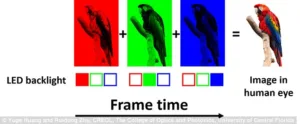Researchers at the University of Central Florida have been working on frame sequential LCDs with the LC material being blue phase molecules. The team under Shin-Tson Wu of the College of Optics and Photonics (CREOL) of the University of Central Florida, USA has published a paper in Optical Materials Express that describes work done with AUO to develop an LCD that used an IPS structure with blue phase materials to create an LCD that can be operated at 240Hz as long as Oxide TFTs are used.
The team worked to reduce the voltage needed to drive the material and found that using a protruding triangular electrode structure, it was able to reduce the drive voltage to 15V, when transmittance was 74%. The group also found that as few as two domains could provide accurate gamma at different viewing angles.
One of the issues faced by blue phase materials is temperature range and the group said that it was able to operate from -20ºC to 75º C.
The material, called JC-BP08 has been developed with JNC of Japan that has a delicate balance between operating voltage, response time and charging time to create a practical material that can be used at 240Hz.
Analyst Comment
Frame sequential LCD operation has long been a target for panel makers. The technique should allow significantly lower power consumption and/or higher resolution, both of which are worth chasing. Blue phase has been a ‘promising technology’ for a long time – Samsung promoted the materials as the future for LCDs around 2008/2009, based on their high speed potential. Base blue phase materials have a very limited temperature range but by combining them with polymers the temperature range can be extended, although I don’t remember seeing such a wide range as the group achieved before.
We reported from SID last year that Merck was working on BP materials, but although response times were 1ms, voltages needed were around 40V (LC Materials Are Still Improving, Says Merck (BC16)
Sharp had a small transparent FS LCD at ISE but there wasn’t a lot of information (although we’re still trying to get more – watch for our ISE report)(BR)

